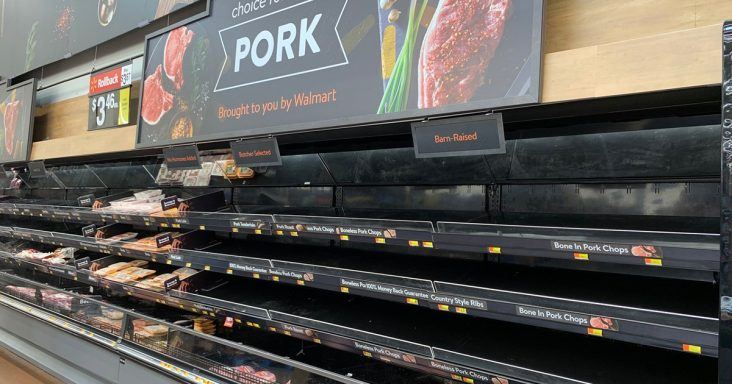Survey: Consumers see product shortages as ‘new normal’
by April 20, 2022 1:43 pm 1,056 views

Pork meat cases at a Walmart Supercenter in Jane, Mo are mostly empty as the retail giant has issues getting and keeping pork items in stock.
Consumers are accustomed to seeing grocery and retail store shelves almost empty. Supply chain disruptions and shifting consumer spending patterns that began with COVID-19 continue to be a supply-demand challenge for retailers and product manufacturers.
While consumers are trying to resume normal activities, a majority think product shortages are here to stay, according to a recent survey by SAP. The marketing group found 67% of respondents think product shortages are a “new normal” and 74% said shortages will continue to dominate supply chain conversation this year and into next.
The biggest shortages are in food, according to 77% of the respondents and 52% expressed concern about the availability of personal care items, and 32% worry they may be unable to fill medical prescriptions.
Nearly 9 in 10 of the respondents have experienced shortages and 70% of them don’t think brands or retailers have effectively communicated about their supply chain challenges. Due to out-of-stock issues, 66% of consumers have bought brands they normally would not have. Almost one-third of respondents said they have stopped purchasing from at least one retailer altogether due to supply chain challenges.
“The survey makes clear that as we move into the third year of the pandemic, many consumers see a future with some empty shelves,” said Tony Harris, chief marketer at SAP Business Network. “In particular, they fear shortages of food, hygiene supplies, and prescription medicine. As procurement and supply chain leaders, we cannot change the course of world events. However, we can help consumers by making supply chains more resilient, which can limit the impact of these events.”
Supply chain analysts have said the ongoing Russian invasion of Ukraine will make supply chain matters worse for food makers that use wheat, seed oils, corn and other grains. While most of the Ukrainian exports are to China, grain and seed oil prices remain elevated from the lost production expected in a war-torn Ukraine.
Economists at Well Fargo anticipate commodity prices could increase another 4% to 5% because of the ensuing supply constraints. Aside from the war, analysts said China’s harsh COVID lockdowns in major cities create supply chain headaches for many U.S. businesses.
Flexport, a logistics operator at the Shanghai port, said this week trucking has been slowed to standstill in Shanghai. Drivers who enter the ports must show negative COVID results from the past 24 hours. Flexport said delays in receiving test results is resulting in a logistical nightmare to get goods in and out of the port. Everstream analytics reports a 30% decline in efficiency due to lack of trucking transport at the port of Shanghai this month. Companies are starting to divert cargo away from Shanghai.
The neighboring city of Kunshan has also been on lockdown since early April. Kunshan is a major export city for automobile and electronics supply chains which continues to be a problem for U.S. businesses. Wells Fargo economists said last week that the closings of key trading hubs in China amid COVID outbreaks will dent recent supply chain progress.
“Our baseline expectation is that supply chain disruptions are not fully resolved until well into next year. Manufacturers should continue to chip away at the large amount of order backlog as they obtain inputs, which should sustain continued growth in equipment spending,” noted Jay Bryson, chief economist at Wells Fargo Securities.
He said while the U.S. has shuffled some of the growth in inventories between quarters, Wells Fargo expects a gradual return to a pre-pandemic inventory-to-sales ratio throughout 2023.
